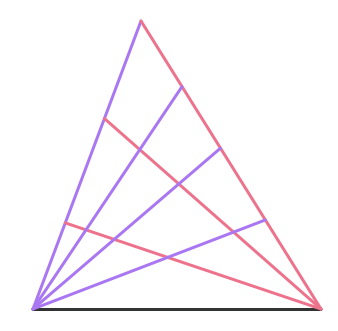Carefully Count Triangles

How many triangles are there?
Make sure you get all the small ones!
The answer is 42.
This section requires Javascript.
You are seeing this because something didn't load right. We suggest you, (a) try
refreshing the page, (b) enabling javascript if it is disabled on your browser and,
finally, (c)
loading the
non-javascript version of this page
. We're sorry about the hassle.
4 solutions
I'm somewhat surprised that this question is so hard. Any ideas why?
Actually, you are right about counting the number of triangles. :)
Log in to reply
:) I've removed that first sentence.
Is there a better way to approach this? Doesn't really seem that way, since even having lines from 1 vertex requires the work of "2 purple lines".
You can count it as follows.
For triangles having pink lines as a side and bottom left vertex of the large triangle as a vertex, we need to choose 2 points out of 5 for every of 3 pink lines: ( 2 5 ) × 3 = 3 0
For triangles having purple lines as a side and bottom right vertex of the large triangle as a vertex, we need to choose 2 points out of every 4 − 1 = 3 points on each of 4 purple lines. We count 4 − 1 as we bypass already counted triangles with bottom left vertex of the large triangle : ( 2 3 ) × 4 = 1 2
Total is 3 0 + 1 2 = 4 2
Nicer way to count :)
Do you know what happens if we also had lines from the other vertex, and assume that no three lines are concurrent?
Log in to reply
Let's say we had one more line from the top vertex. In total we would have 9 lines. We choose 3 lines out of 9 : ( 3 9 ) = 8 4 We would need to subtract triples that come from a common vertex: ( 3 5 ) + ( 3 4 ) + ( 3 3 ) = 1 0 + 4 + 1 = 1 5 8 4 − 1 5 = 6 9
Log in to reply
Oh, very nice. I think this would make for a great question, even with just 1 added line at the top vertex.
I had to think for a while to see why your approach works.
It can be seen that every line intersects all other lines.So the the number of triangles will be the number of ways of choosing three lines from the 8 lines which is 8C3.But problems remain.It can be noticed that there are two vertices of the triangle ,in one of which 5 lines intersects each other and in the other vertice ,4 lines intersects each other.So no triangle will be formed if we choose three lines from that 5 lines or from that 4 lines.So by subtraction ,we get that the number of ways must be 8C3-(5C3+4C3)=42.
That's a great bijection!
Very similar to @Maria Kozlowska 's approach in the comments, on how to deal with lines from all 3 vertices.
Had the triangle been larger, I'd probably have gone for combinatorics too, but this approach was very quick mentally:
There are 6 triangles involving (and below) the top vertex.
If we move one "unit" away from that vertex we can get to two vertices. For each of these vertices there are 5 (one less) triangles involving them that are below them.
Not including the two vertices at the base (which have no triangles below them), we have 12 vertices we can eventually move to.
So, continuing in this way, we get 6 + 5 + 5 + 4 + 4 + 4 + 3 + 3 + 3 + 2 + 2 + 1 = 42.
Thanks for sharing the direct counting way. That's how I got started with these types of problems, and after a while just went for the combinatorics solution. It's good to get back to basics once in a while(, and sometimes the basic approach works much better).
First, if the triangle involves the black base , then, as Geoff points out , we have to select 1 of 4 purple lines and 1 of 3 pink lines, so the number of such triangles is:
4 × 3 = 1 2
Second, if the triangle doesn't involve the black base, then (at least) 2 of the lines must have the same color. Let's consider the case of 2 purple lines . For each pair of purple lines, we can cap it off with any of the 3 pink lines, so the number of such triangles is:
( 2 4 ) × 3 = 1 8
Third, we consider the case of 2 pink linkes . For each pair of pink lines, we can cap it off with any of the 4 purple lines, so the number of such triangles is
( 2 3 ) × 4 = 1 2
It is clear that there are no triangles which use 3 purple lines or 3 pink lines. Hence, in total, the number of triangles is 1 2 + 1 8 + 1 2 = 4 2 .
Is there a better way to approach this problem?